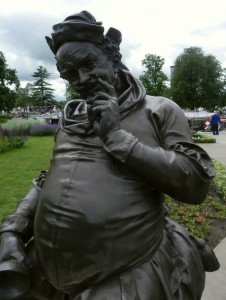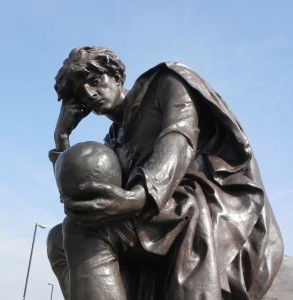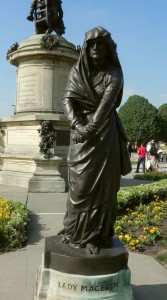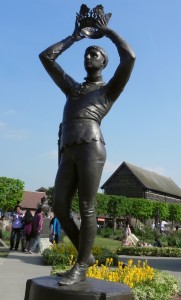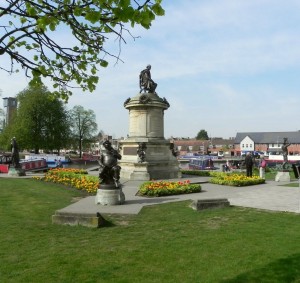 For Bastille Day, a post about a much-loved monument that originated in France. If you’ve ever visited Stratford-upon-Avon the chances are you’ve seen the Gower Memorial, even if only from the window of a bus. It now sits alongside the main road into the town near Clopton Bridge, with the Royal Shakespeare Theatre visible behind. But how many people realise it could claim to be the most accomplished Shakespeare statue in the world?
For Bastille Day, a post about a much-loved monument that originated in France. If you’ve ever visited Stratford-upon-Avon the chances are you’ve seen the Gower Memorial, even if only from the window of a bus. It now sits alongside the main road into the town near Clopton Bridge, with the Royal Shakespeare Theatre visible behind. But how many people realise it could claim to be the most accomplished Shakespeare statue in the world?
Its history goes back over 130 years, when a number of memorials to Shakespeare were contributed to the town. After much debate it was decided that the most suitable grand memorial in the town should be a theatre, leading to the opening of the Shakespeare Memorial Theatre in 1879. However this didn’t prevent a number of other memorials including the American Fountain in 1887.
The story of the Gower memorial is long and complicated. It’s named after its creator, Lord Ronald Gower, a talented artist whose work has been undervalued because he was a gentleman amateur with every advantage: wealth, education and position. His mother was a close friend of Queen Victoria and he knew the politicians he sculpted, Disraeli and Gladstone, personally. He was also a friend of Oscar Wilde and of John Millais, who painted his portrait. According to The English Illustrated Magazine of 1895, he “has known everyone worth knowing, from Garibaldi and Longfellow to the Empress Eugenie.”
Gower had a passion for art, and was a Trustee of the National Portrait Gallery where he became an authority on Shakespeare portraiture. In 1875 he moved to France to pursue his interest, joining the workshop of Albert Carrier-Belleuse which specialised in statuettes of historical personages. Rodin was a former apprentice. The connection did not last long and Gower soon set up up on his own in collaboration with a talented Italian sculptor Luca Madrassi. He was to spend a number of years in Paris.
The Leicester Square, London statue of Shakespeare had been unveiled in 1874, and in 1877 the foundation stone for the Memorial Theatre in Stratford had been laid, shifting his thoughts there. His first reference to the idea of creating his own monument dates from the same year. There were already two statues of Shakespeare in Stratford though neither was conspicuous and his ambitious plan was to include four statues of characters from the plays as well as a bust of Shakespeare crowned by figures representing Comedy and Tragedy.
In 1881 a plaster cast of his proposed Shakespeare monument was put on display in Paris. The creation of bronze sculpture is a complex process, and Gower sculpted the figures in clay before creating the plaster casts. The figures and decorative bronze work were cast in France by three different specialist foundries.
The choice of characters was Hamlet representing Philosophy, Prince Hal representing History, Falstaff representing Comedy and Lady Macbeth representing Tragedy. With the exception of Falstaff the statues all show the characters at a recognisable moment in the play. Hal holds his father’s crown aloft before placing it on his own head, Hamlet contemplates the skull of Yorick, and Lady Macbeth obsessively washes her hands while sleepwalking. The original concept of a bust of Shakespeare was rethought only a year or so before the completion of the monument when the seated but dynamic figure of Shakespeare was created.
The monument was put in place in 1888 outside the Memorial Theatre, Shakespeare facing Holy Trinity Church. Each statue was set in the alcove between the masks and flowers, creating a more integrated composition than how it appears now. Apart from an address by Oscar Wilde, the October opening ceremony was low-key. It was several years before Gower would allow his name to be added to it, and although large, it’s an unpretentious monument by a modest artist.
The statue was untouched by the fire which destroyed much of the Memorial Theatre in 1926, but the designs for the new theatre would have left the Gower Memorial around the back so in 1933 the whole thing was transported a few hundred yards to the main road. The figures were moved away from the monument, and shifted around to follow its angles rather than its sides. It may not now have the impact that its creator intended but it’s seen and enjoyed by more people than he could ever have anticipated.
Sadly, it’s the figure of Shakespeare himself who is difficult to see, being so high up that only the local bird population get close to him. I always find it irritating that the figure of Shakespeare is rarely cleaned to remove what the birds leave behind. It also originally held a quill in his right hand, lost at some point in its history and never replaced, a particularly sad fate for a sculpture of the most celebated writer in the world.

